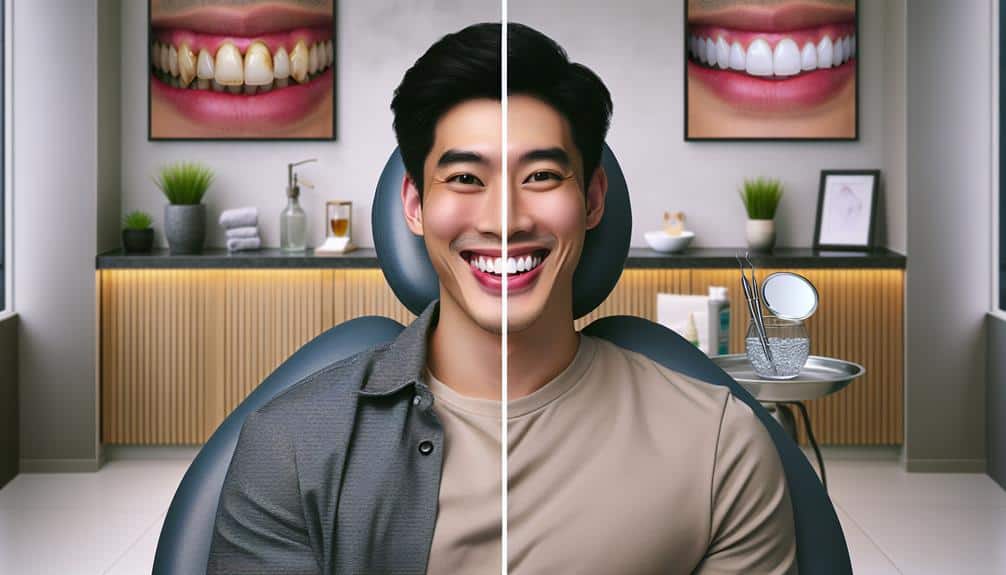Remove red wine stains from your teeth by following these steps: Brush at a 45-degree angle in circular motions with a soft-bristled toothbrush for at least two minutes daily. Opt for whitening toothpaste with stain-removing ingredients like hydrogen peroxide or baking soda. Use whitening strips correctly by drying teeth, applying evenly, and avoiding gums. Keep whitening trays clean, well-fitted, and bacteria-free for efficient stain removal. Consult dental professionals for in-office bleaching or at-home professional kits for personalized treatment. Enhance your smile with these proven methods.
Key Points
- Rinse mouth with water after consuming wine
- Brush teeth with whitening toothpaste
- Use whitening strips or trays for deeper stains
- Consider professional whitening treatments
- Visit dentist for specialized advice and care
The Right Brushing Technique
To effectively eliminate wine stains from your teeth, master the correct brushing technique. Begin by holding your toothbrush at a 45-degree angle towards your gum line. This position allows the bristles to reach the spaces between your teeth where wine stains tend to accumulate. Brush using gentle pressure in a circular motion, ensuring that you cover the front, back, and chewing surfaces of your teeth.
When brushing, pay special attention to areas where stains are prominent, such as the front teeth. Use a soft-bristled toothbrush to prevent damage to your enamel while efficiently removing stains. Remember to brush for at least two minutes to thoroughly clean your teeth and remove any lingering wine residue.
Proper brushing technique is essential in maintaining a healthy and stain-free smile. By brushing at the correct angle with gentle pressure, you can effectively remove wine stains and prevent future discoloration. Incorporate this technique into your daily oral care routine for best results.
Choosing the Best Whitening Toothpaste
For best results in removing wine stains from your teeth, choosing the top whitening toothpaste is vital. When selecting a whitening toothpaste, consider the following:
- Toothpaste Ingredients: Look for components like hydrogen peroxide, baking soda, or activated charcoal, known for their stain-removing properties.
- Whitening Benefits: Opt for toothpaste that specifically mentions whitening advantages on the packaging to make sure it targets stains effectively.
- ADA Approval: Choose a toothpaste with the American Dental Association (ADA) seal of approval to guarantee its safety and effectiveness.
When browsing through different options, examining the toothpaste ingredients is essential. Ingredients like hydrogen peroxide help break down stains, while baking soda acts as a mild abrasive to scrub away discoloration. Additionally, activated charcoal is known for its ability to absorb stains and toxins.
Selecting a toothpaste that highlights whitening benefits ensures you're using a product specifically formulated to combat stains, helping you achieve a brighter smile.
Implementing Whitening Strips Effectively
When using whitening strips, make sure to use the correct application technique for best results. To start, thoroughly dry your teeth before applying the strips to ensure they adhere properly. Position the strip over your teeth, gently pressing to secure it in place. Avoid covering your gums as this can cause irritation. Leave the strips on for the recommended amount of time as specified in the product instructions.
For effective whitening, ensure the whitening gel application is even across all teeth. Gently massage the strips to ensure the gel makes contact with all surfaces. Some whitening strips are designed for overnight whitening techniques. If using these, make sure to follow the guidelines provided by the manufacturer to prevent overuse, which can lead to tooth sensitivity.
Overnight whitening techniques can be more potent, so it's important to follow the recommended usage to avoid damaging your teeth or gums. Consistent and correct application of whitening strips will help you achieve a brighter, stain-free smile.
Utilizing Whitening Trays Correctly
Guarantee correct usage of whitening trays by following these steps to achieve peak results in brightening your smile.
- Essential Tray Maintenance: Properly clean your whitening trays after each use to prevent bacteria buildup and ensure their effectiveness.
- Effective Time Management: Adhere to the recommended duration for each whitening session to avoid sensitivity issues and maximize the whitening effects.
- Customized Tray Fit: Ensure your whitening trays fit snugly against your teeth to guarantee even whitening and prevent the gel from spreading to your gums.
Maintaining your whitening trays is essential for best results. Regularly cleaning them with a gentle brush and lukewarm water can prevent discoloration and maintain their efficiency.
Effective time management is key; follow the instructions provided with your whitening kit to achieve the desired results without causing harm to your teeth.
Lastly, a proper fit is crucial to avoid uneven whitening and gum irritation. Take the time to ensure your trays fit comfortably and securely to enhance the whitening process and protect your oral health.
Understanding Professional Whitening Options
Regularly consulting with a dental professional can provide valuable insight into the various professional whitening options available to enhance your smile's brightness. Professional treatments offer a more potent and quicker solution compared to at-home options.
One common professional whitening method is in-office bleaching, where a high concentration of whitening solution is applied to your teeth under controlled conditions. This method usually requires one or more visits to achieve the desired results.
Another professional treatment option is at-home professional whitening kits prescribed by your dentist. These kits include custom-made trays that fit your teeth precisely, guaranteeing even application of the whitening gel. Your dentist will provide detailed instructions on how to use these kits effectively and monitor your progress to ensure safety and efficacy.
While professional whitening options may come at a higher cost, the results are often more dramatic and long-lasting compared to at-home treatments. Consulting with your dental professional can help you determine the most suitable whitening option based on your needs and preferences.
Frequently Asked Questions
Can Drinking Water After Consuming Wine Help Prevent Wine Stains on Teeth?
After sipping wine, hydrating with water can help prevent teeth stains. While it doesn't erase the past, the simple act of drinking water may dilute the pigments, making them less likely to cling to your teeth.
Are There Specific Foods or Drinks That Can Help Naturally Whiten Teeth and Reduce Wine Stains?
To naturally whiten teeth and reduce wine stains, consider incorporating foods like strawberries and pineapple into your diet. These fruits contain enzymes that can help break down stains. Additionally, crunchy vegetables like carrots can help scrub away surface stains.
How Often Should I Visit the Dentist for Professional Teeth Whitening Treatments to Maintain a Wine-Stain-Free Smile?
For a pristine, wine-stain-free smile, schedule regular dental check-ups for professional whitening treatments. Aim for yearly visits to maintain that radiant grin and prevent those pesky wine stains from taking center stage on your teeth.
Are There Any Home Remedies or DIY Solutions for Removing Wine Stains From Teeth?
To remove wine stains from teeth, try a mixture of lemon juice and baking soda. Gently brush this paste on your teeth, letting it sit for a few minutes before rinsing. Remember, excessive use can damage enamel, so use sparingly.
Can Certain Medications or Health Conditions Make Teeth More Prone to Staining From Wine or Other Beverages?
Certain medications can impact tooth staining while some health conditions may lead to teeth discoloration. Be cautious with substances like wine that can exacerbate staining. Consult your healthcare provider for advice on managing tooth discoloration related to medications or health issues.



